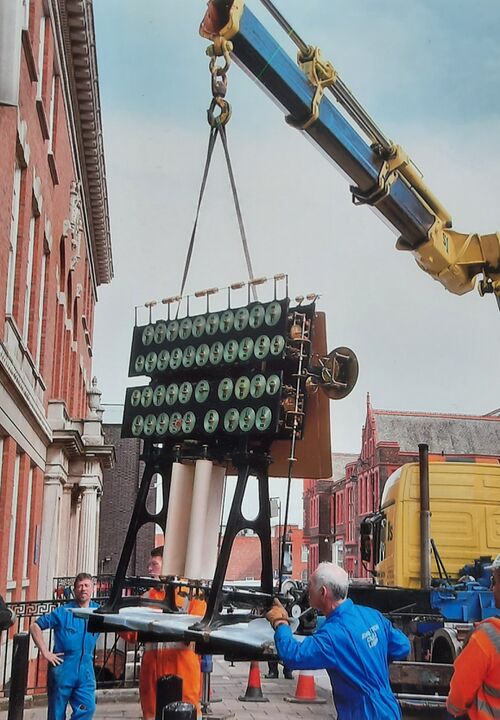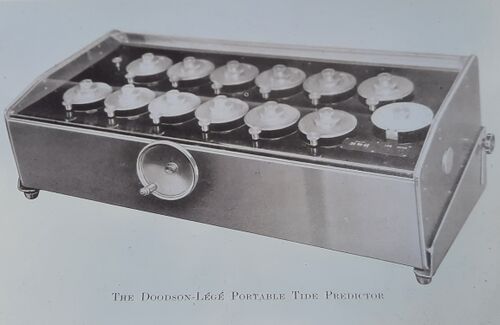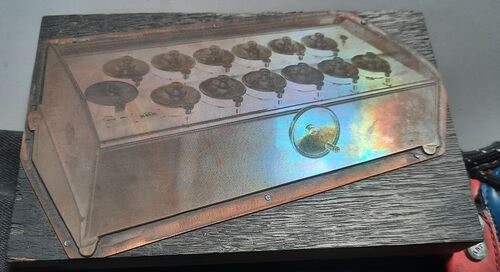Difference between revisions of "The Doodson-Légé Tide Predicting Machine"
m |
|||
| Line 11: | Line 11: | ||
<blockquote>Tidal predictions were first carried out in 1924 at Bidston Observatory (University of Liverpool Tidal Institute), initially by hand and then by early tide predicting machines.<ref>https://ntslf.org/about-tides/doodson-machine</ref></blockquote> | <blockquote>Tidal predictions were first carried out in 1924 at Bidston Observatory (University of Liverpool Tidal Institute), initially by hand and then by early tide predicting machines.<ref>https://ntslf.org/about-tides/doodson-machine</ref></blockquote> | ||
| − | [[File:Doodson-Lege.jpg|thumb|none|500px|The Doodson-Légé Tide Prediction Machine that was removed from Bidston Observatory, craned into building]] | + | [[File:Doodson-Lege.jpg|thumb|none|500px|The Doodson-Légé Tide Prediction Machine that was removed from Bidston Observatory, being craned into the Joseph Proudman building at the National Oceanography Centre in Liverpool. It is now part of the Tide and Time exhibition]] |
<blockquote>The Doodson-Légé tide predicting machine c.1950, probably at Bidston Observatory, Wirral second largest tide predicting machine ever built. This was a development from the earlier Roberts-Légé machine and designed by Arthur Doodson in the late 1940s and manufactured by Légé & Co. around 1948-49. This much bigger machine was “easier” to set up and, after some additional mechanism added a few years later, could calculate the high and low tide levels and their times at once - effectively halving the time it took on the older Roberts-Légé machine. It is estimated that, using the Doodson-Lége machine, it could take almost a month to calculate a year’s worth of tidal levels for a particular port and these were calculated a couple of years in advance. In comparison, it takes the computers used today a fraction of a second to do the same calculation to greater accuracy. Throughout the 1950s though, this machine was state-of-the-art. Installing the machine at the National Oceanographic Centre Installing the machine at the National Oceanographic Centre The 1.8 ton Doodson-Légé and the 1.2 ton Roberts-Légé machines were recently transported to the NOC’s Joseph Proudman Building. The process took 5 ½ hours and required a large team of people. Staff at the NOC were in a jubilant mood watching the installation and cheered as the first machine to be lifted, the Roberts-Légé machine, touched down on the pavement beside the Proudman Building. The Doodson-Légé machine is a particularly symbolic object for them as it was at the heart of their tide prediction work for international ports from c1950 to the early 1960s." | <blockquote>The Doodson-Légé tide predicting machine c.1950, probably at Bidston Observatory, Wirral second largest tide predicting machine ever built. This was a development from the earlier Roberts-Légé machine and designed by Arthur Doodson in the late 1940s and manufactured by Légé & Co. around 1948-49. This much bigger machine was “easier” to set up and, after some additional mechanism added a few years later, could calculate the high and low tide levels and their times at once - effectively halving the time it took on the older Roberts-Légé machine. It is estimated that, using the Doodson-Lége machine, it could take almost a month to calculate a year’s worth of tidal levels for a particular port and these were calculated a couple of years in advance. In comparison, it takes the computers used today a fraction of a second to do the same calculation to greater accuracy. Throughout the 1950s though, this machine was state-of-the-art. Installing the machine at the National Oceanographic Centre Installing the machine at the National Oceanographic Centre The 1.8 ton Doodson-Légé and the 1.2 ton Roberts-Légé machines were recently transported to the NOC’s Joseph Proudman Building. The process took 5 ½ hours and required a large team of people. Staff at the NOC were in a jubilant mood watching the installation and cheered as the first machine to be lifted, the Roberts-Légé machine, touched down on the pavement beside the Proudman Building. The Doodson-Légé machine is a particularly symbolic object for them as it was at the heart of their tide prediction work for international ports from c1950 to the early 1960s." | ||
Revision as of 11:52, 21 April 2024
The Doodson-Légé Tide Prediction Machine
Having the Bidston Kelvin Machine and the Roberts Tide Prediction Machine available
"equipped Doodson with experience that would prove invaluable when considering the design of later machines. They would also provide him with the means to enable the Liverpool Tidal Institute to become one of the main producers of tide tables worldwide. The two machines were to play particularly important roles in World War II, in providing tidal predictions for D-Day and for other military operations in Europe and the Pacific. Those for D-Day were unusual in that they were made for an unknown location (now of course known to be Normandy), using only the crudest of harmonic constants provided by Commander Farquharson at the Tidal Branch of the Admiralty (Parker, 2011). However, they were not secret for long. In July 1944, Doodson gave a lengthy interview to the Liverpool Daily Post, stressing the importance of the TPMs to the D-Day predictions (LDP, 1944).
"In 1947, Doodson asked Légé to estimate the price of a machine with at least 35 components. Légé produced an initial design which Doodson started working on in detail. This became the 42-component machine delivered finally by Légé in December 1950 at a cost of GBP 5049 (Woodworth, 2016)."
"After the Bidston Kelvin Machine and the Roberts Tide Prediction Machine, the Bidston Doodson–Légé Machine (TPM-S20), which was referred to by Bidston staff as the “D–L machine”, was the third machine to be used operationally at the LTI and one of a number of similar machines made by Légé & Co. under Doodson’s supervision and exported to several countries. Doodson (1951) describes it in some detail. It was a single-sided TPM, being converted to a double-sided machine in 1956. It has an aluminium frame, unlike the steel frame of TPM-S5. The machine is approximately 7 feet (2.1 m) high, 9.5 feet (3 m) long and 3.5 feet (1.1m) wide and weighs 1.4 t (not including the support base frame). Complete engineering drawings and documentation survive which have enabled its recent restoration.7Figure 3f and g provides photographs of the machine."[1]
Tidal predictions were first carried out in 1924 at Bidston Observatory (University of Liverpool Tidal Institute), initially by hand and then by early tide predicting machines.[2]
The Doodson-Légé tide predicting machine c.1950, probably at Bidston Observatory, Wirral second largest tide predicting machine ever built. This was a development from the earlier Roberts-Légé machine and designed by Arthur Doodson in the late 1940s and manufactured by Légé & Co. around 1948-49. This much bigger machine was “easier” to set up and, after some additional mechanism added a few years later, could calculate the high and low tide levels and their times at once - effectively halving the time it took on the older Roberts-Légé machine. It is estimated that, using the Doodson-Lége machine, it could take almost a month to calculate a year’s worth of tidal levels for a particular port and these were calculated a couple of years in advance. In comparison, it takes the computers used today a fraction of a second to do the same calculation to greater accuracy. Throughout the 1950s though, this machine was state-of-the-art. Installing the machine at the National Oceanographic Centre Installing the machine at the National Oceanographic Centre The 1.8 ton Doodson-Légé and the 1.2 ton Roberts-Légé machines were recently transported to the NOC’s Joseph Proudman Building. The process took 5 ½ hours and required a large team of people. Staff at the NOC were in a jubilant mood watching the installation and cheered as the first machine to be lifted, the Roberts-Légé machine, touched down on the pavement beside the Proudman Building. The Doodson-Légé machine is a particularly symbolic object for them as it was at the heart of their tide prediction work for international ports from c1950 to the early 1960s." [3]
The Portable Doodson-Légé Tide Prediction Machine
Portable Tide Prediction Machine appear in inventories as 'PTPM'[4]
- ↑ Tide prediction machines at the Liverpool Tidal Institute, March 2020History of Geo- and Space Sciences 11(1):15-29, DOI:10.5194/hgss-11-15-2020, Philip L. Woodworth
- ↑ https://ntslf.org/about-tides/doodson-machine
- ↑ https://www.liverpoolmuseums.org.uk/stories/tide-predicting-machines-restored-and-re-displayed
- ↑ https://www.researchgate.net/figure/a-Inventory-of-tide-prediction-machines-b-Inventory-of-portable-tide-prediction_tbl1_340064506


